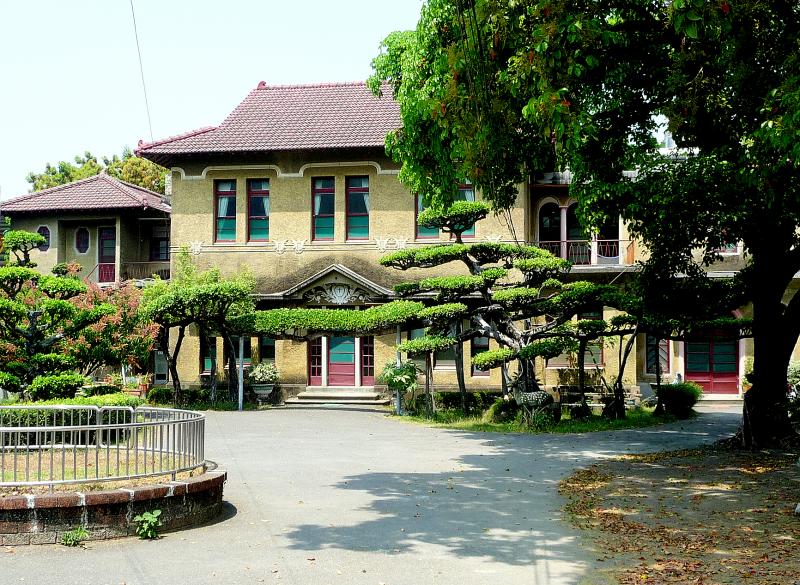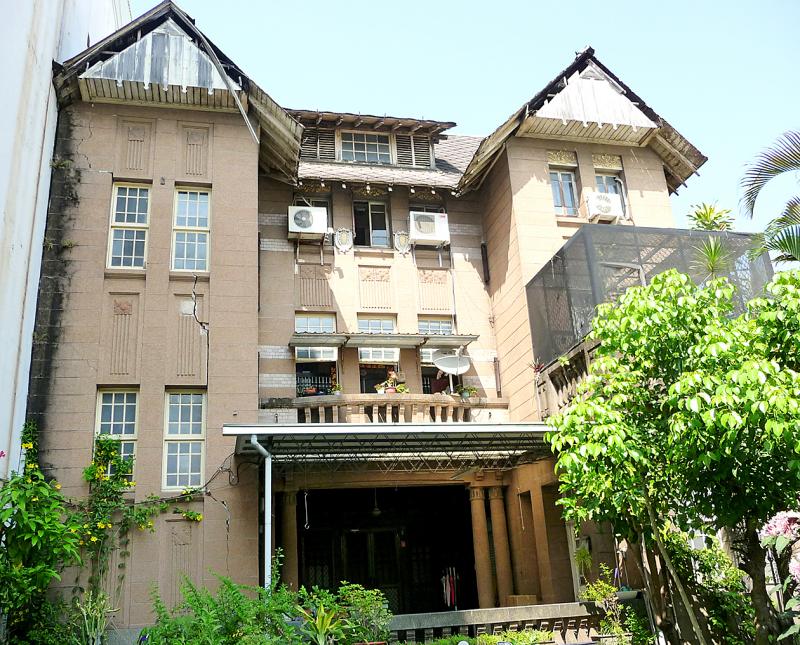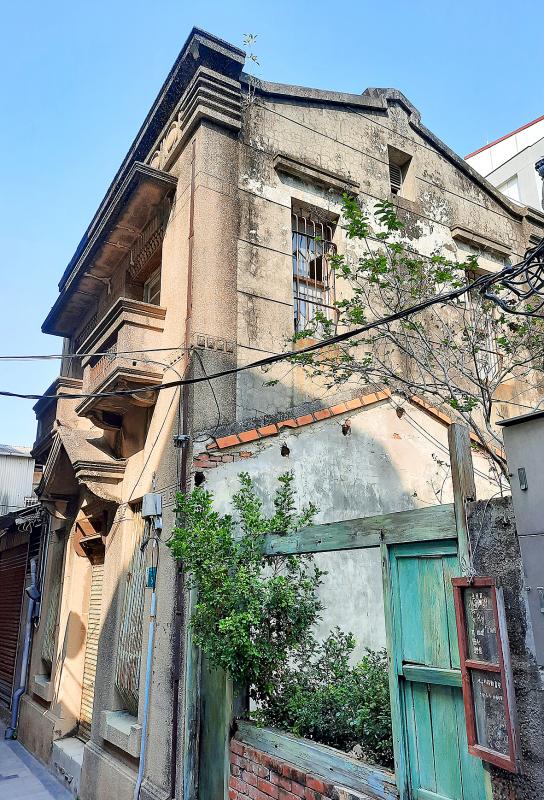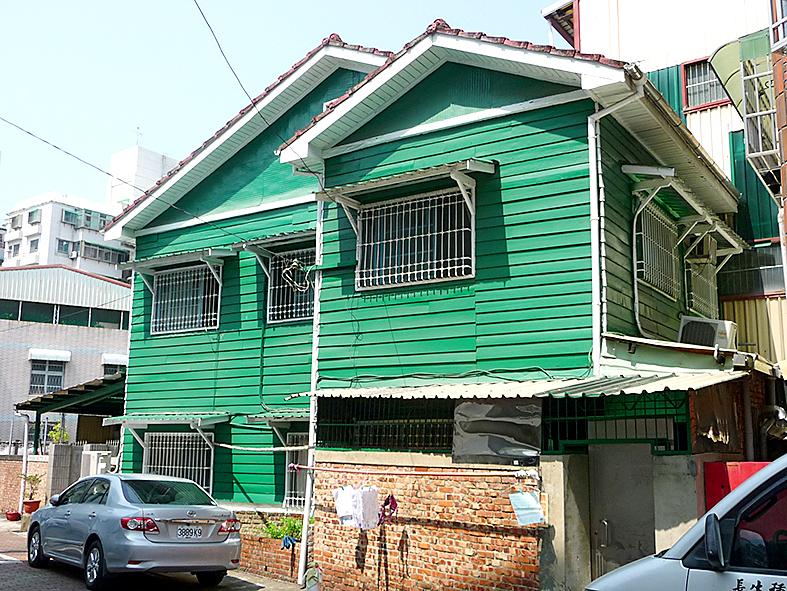The groundwork for this article was exactly that: Time and shoe leather, invested in a hunt for old yet charmful residences in the winding back alleys of Tainan.
While confirming the locations of certain buildings I’d previously blundered across, I found a few more gems. There are others out there, I’m sure.
AROUND THE DIOCESE

Photo: Steven Crook
I started near the southern end of Changrong Road (長榮路), which is named for Chang Jung High School (長榮中學), founded by Presbyterian missionaries in the late 1880s. However, there’s no link between the structure I wanted to look at and that Protestant institution.
The elegant two-story mansion at 15 Changrong Road Section 2, officially known as the Tainan Diocese Office (台南教區辦事處), belongs to the Catholic Church. Since 1961, it’s been the administrative base of the Bishop of Tainan, whose area of responsibility includes Penghu County.
No one seems to be sure of its year of construction, but this building has been marked on street plans since 1941. In terms of appearance, it certainly looks as if it could’ve been built during the 1895 to 1945 period of Japanese occupation. The walls are reportedly reinforced concrete.

Photo: Steven Crook
Just below the second-floor windows, two horizontal streamlines punctuated by six identical embossments break up the brown pebbledash. Some bloggers claim the embossed motifs are harps (a symbol of Catholicism), but I couldn’t get close enough to be sure.
On the left, there’s a smaller and slightly shorter house in the same style, with octagonal windows and a balcony.
About 100m west of the Tainan Diocese Office, a dark green clapboard house caught my eye as soon as I glanced down Lane 19, Shengli Road (勝利路19巷).

Photo: Steven Crook
According to the friendly lady who lives there, it’s about 60 years old, and is a rare survivor of a once-common type of middle-class residence. It can get uncomfortably cold indoors during the winter, she told me, but summer temperatures are quite bearable.
Searching for a shortcut, I squeezed between some houses and found myself in Lane 211, Dongmen Road Section 1 (東門路一段). My eyes were immediately drawn to the “hard hill roof” (硬山頂), blue fascia, and red bricks of no. 2 — features which suggested that here was an abode built before the Japanese occupation. That, or it was for a client uninterested in the architectural fashions the colonizers had imported.
The wall between the lane and the property has a newspaper-sized opening. Through it, I glimpsed an uncluttered courtyard and a well-maintained entranceway. The building includes wood columns and screens, so I wasn’t surprised to see three fire extinguishers positioned where they could be utilized in an emergency.

Photo: Steven Crook
Unfortunately, there was no one around who could tell me anything about this delightful relic, and I’ve not been able to find anything about it online.
FAMILY MANSIONS
Later the same morning, I dived into a neighborhood bordered by Haian Road Section 2 (海安路二段) and Minzu Road Section 3 (民族路三段).

Photo: Steven Crook
Hoping to get a better look at the long-shuttered Sinfusing Textiles Factory (新復興紡織廠) — a magnet for urbex types — I walked southwest along Lane 46, Sinyi Street (信義街).
When I reached the property that bears the numbers 13, 15 and 17, I stopped thinking about the old factory, and turned my attention to a two-story colonial period pile obscured by overgrown trees and shrubs. It’s in poor condition; the pigeon coop atop its roof adds insult to injury. But I could see enough to know that, in its heyday, it must have been quite an edifice.
Googling the address threw up a few bits of information. It was built by a family surnamed Huang (黃), and the reason why it hasn’t been cleared for redevelopment is also the reason why the house hasn’t been fixed up. With the passing of a few generations, ownership has splintered. So many people now share the title that getting all of them to agree on a course of action is close to impossible.
I intended to restrict this article to houses which are effectively invisible to people driving through the city. However, the Weng Family Western-Style Mansion (翁氏洋樓), at 112 Minzu Road Section 3, is on one of the city’s busier arteries.
That said, it’s set a fair way back. What’s more, at this time of year passersby are more likely to notice the magnificent blossoms adorning the tree at the front of the property than the building itself.
Also known as Weng Lo’s House (翁螺宅), after the Fujian-born tycoon/philanthropist who commissioned its construction in 1929, it’s a three-story Bavarian-style mansion that’s almost unique in Taiwan.
Potted plants and umbrellas by the front door show that people still live here, despite the nasty vertical cracks evident on the western half of the facade. The frame is fir wood and the concrete exterior is unreinforced, so the structure isn’t as robust as that of a modern house.
The roof is covered with copper tiles. The top floor includes a ballroom and an attic with dormer windows.
According to an interview given by a family member some years back, a hidden passageway connects a closet in one room with the attic. After the 228 Incident in 1947, an anti-government uprising that was violently suppressed, the Weng family used it to shelter more than 20 people who’d gone into hiding.
On the second floor, there’s a balcony in the center and a terrace on the eastern side of the building.
Chen Yi-ho’s former residence (陳一鶴故居) at 56 Chikan East Street (赤崁東街) is almost as old and almost as impressive as the Weng landmark. Chen, a physician like his father, was a cultural figure in post-war Tainan.
Even though the building is clearly unoccupied, it seems far from collapse. The garden is overgrown, but the wooden window frames look intact.
From the front, the two-story house appears to be symmetrical. It’s possible to walk almost all of the way around the oddly-shaped piece of land on which it stands, and from the back you’ll see an extension (obviously added long after construction) and a tower-like square room accessing a roof terrace.
SNAIL ALLEY
An hour of prime daylight remained, so I rode 700m south to the neighborhood now promoted as Snail Alley (蝸牛巷). It’s just west of Yongfu Road Section 2 (永福路二段).
On Lane 157, Minsheng Road Section 1 (民生路一段) I found a two-floor house I’d love to have as my city-center base, even though its footprint is a mere third of most convenience stores.
Externally, no. 5 bears some resemblance to the colonial-era Baroque/Art Deco shop-houses which line the old streets of Sinhua (新化) and Madou (麻豆) in inland Tainan. But I don’t think it was built for doing business, because the entrance is no bigger than a standard doorway.
If you come here, devote a few minutes to the pair of tiny balconies and the decorative highlights above the door. The southern side of the house bears the imprint of a long-gone neighboring building that was probably even older. This — the antiquity that’s visible around every corner — is why I love Tainan.

The canonical shot of an East Asian city is a night skyline studded with towering apartment and office buildings, bright with neon and plastic signage, a landscape of energy and modernity. Another classic image is the same city seen from above, in which identical apartment towers march across the city, spilling out over nearby geography, like stylized soldiers colonizing new territory in a board game. Densely populated dynamic conurbations of money, technological innovation and convenience, it is hard to see the cities of East Asia as what they truly are: necropolises. Why is this? The East Asian development model, with

June 16 to June 22 The following flyer appeared on the streets of Hsinchu on June 12, 1895: “Taipei has already fallen to the Japanese barbarians, who have brought great misery to our land and people. We heard that the Japanese occupiers will tax our gardens, our houses, our bodies, and even our chickens, dogs, cows and pigs. They wear their hair wild, carve their teeth, tattoo their foreheads, wear strange clothes and speak a strange language. How can we be ruled by such people?” Posted by civilian militia leader Wu Tang-hsing (吳湯興), it was a call to arms to retake

Desperate dads meet in car parks to exchange packets; exhausted parents slip it into their kids’ drinks; families wait months for prescriptions buy it “off label.” But is it worth the risk? “The first time I gave him a gummy, I thought, ‘Oh my God, have I killed him?’ He just passed out in front of the TV. That never happens.” Jen remembers giving her son, David, six, melatonin to help him sleep. She got them from a friend, a pediatrician who gave them to her own child. “It was sort of hilarious. She had half a tub of gummies,

There is an old British curse, “may you live in interesting times,” passed off as ancient Chinese wisdom to make it sound more exotic and profound. We are living in interesting times. From US President Donald Trump’s decision on American tariffs, to how the recalls will play out, to uncertainty about how events are evolving in China, we can do nothing more than wait with bated breath. At the cusp of potentially momentous change, it is a good time to take stock of the current state of Taiwan’s political parties. As things stand, all three major parties are struggling. For our examination of the